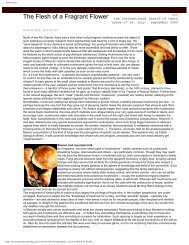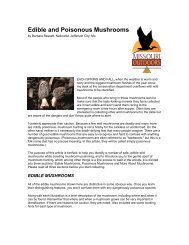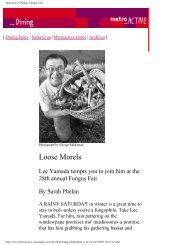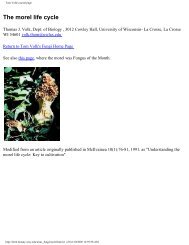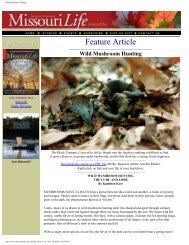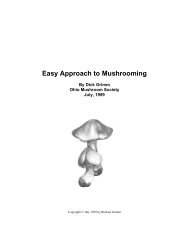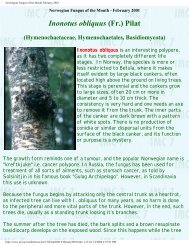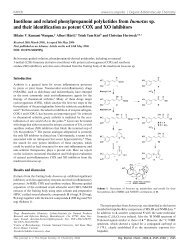Captain Charles McIlvaine - The Mushroom Hunter
Captain Charles McIlvaine - The Mushroom Hunter
Captain Charles McIlvaine - The Mushroom Hunter
Create successful ePaper yourself
Turn your PDF publications into a flip-book with our unique Google optimized e-Paper software.
Notes from Underground - Spring 1999, David Rose, COMA<br />
“Notes from Underground - Spring 1999, by<br />
David Rose<br />
Old Ironguts - <strong>Captain</strong> <strong>Charles</strong> <strong>McIlvaine</strong><br />
This column originally appeared in the Spring 1999 issue of<br />
Spores Illustrated, the newsletter of the Connecticut-Westchester<br />
Mycological Association (COMA).<br />
At COMA'S November meeting, many of us were "hoppin' mad" at the nonchalance of a New<br />
York Times Magazine food columnist who suggested mushrooms add "an element of danger and a dash<br />
of decadence" to a meal. Our objection was obvious: hyping the danger element can lead the unwary to<br />
succumb to the last dinner she or he will ever eat. Period. On the other hand, the culinary allure of<br />
mushrooms and the foolhardy pretense of tempting fate demand to be studied carefully. 'Danger and<br />
decadence' interpretations of fungi have a long history. <strong>The</strong>y stand somewhere between mycophilia and<br />
mycophobia not because fungi delight the palate but because they engage the imagination. <strong>Mushroom</strong>s<br />
tease us with uncertainties but hold fast to their many mysteries by remaining hidden. In fact, the term<br />
'cryptogamia' finds its meaning here. 'Crypto' means 'hidden.' As one author remarked, "<strong>The</strong> greatest<br />
treasures and most wonderful things lie hidden underground - and not without reason."<br />
Consider <strong>Charles</strong> Mcllvaine, author of the classic One Thousand American Fungi. An amateur,<br />
Mcllvaine was a great popularizer of mycology and tireless promoter of mycophagy. In the latter<br />
capacity he achieved a renown not to be matched easily, for his extraordinary appetite for wild<br />
mushrooms included several poisonous species, e.g. Russula emetica and Hypholoma fasciculare.<br />
Incredible as it seems, he ate Hypholomas indiscriminately, insisting "wherever and however they grow,<br />
Hypholomas are safe." During his lifetime (by the way, he did not die of mushroom poisoning)<br />
Mcllvaine consumed prodigious quantities of fungi, edible and otherwise, lavished praise on their<br />
dietary advantages, and convinced others to enjoy them as he did. He once claimed to have eaten 437<br />
species - some say his life total was over 800 - in either case a record certainly worthy of a <strong>Mushroom</strong><br />
Book of Records. Does it surprise us that the good Cap'n Mcllvaine is endeared to some as 'Ole<br />
Ironguts,' the greatest 'toadstool tester' of his time<br />
Born in 1840, Mcllvaine first worked with local Pennsylvania railroads. When the Civil War began, he<br />
led Company H of the 97th Pennsylvania Volunteers as <strong>Captain</strong>. After the war he had yet to discover a<br />
career and in 1873 embarked on his 'grand tour' of Europe, dispatching letters on art criticism home to U.<br />
S. newspapers. Returning home he visited the 'mountain state' of West Virginia in 1880, again employed<br />
by a railroad company. In the decades after the Civil War spectacular forest fires devastated huge areas<br />
of the state's mountainsides, and he readily noticed fungi fruiting in great numbers on the burned-over<br />
hills. As he described one instance, "I saw miles of the blackened district made white by a growth of<br />
http://www.mushroomthejournal.com/coma/nfuspr99.html (1 of 3)12/20/2005 12:45:11 PM
Notes from Underground - Spring 1999, David Rose, COMA<br />
Lactarius piperatus."<br />
At once, it seemed, the mushrooms captured his imagination, and, as with many curious intellects,<br />
changed his life. Just as R. Gordon Wasson preferred to dramatize his beginning in mycology with the<br />
'once-upon-a-time' story of his and Valentina's mushroom honeymoon, Mcllvaine did much the same in<br />
the preface to One Thousand American Fungi: "A score of years ago (1880-1885) I was living in the<br />
mountains of West Virginia. . ." So he inaugurated the story of his happy relationship with "my little<br />
friends - the toadstools . . . my constant companions." Here began a literary career as well as a<br />
mycological one.<br />
Though not well known, Mcllvaine really did manage a sort of literary career. Beginning in the 1880s,<br />
just as he became deeply involved with mycology, he published an assortment of tales, poetry, and<br />
sketches in periodicals such as Lippincott's Magazine, Harpers, and Women's Home Companion. <strong>The</strong><br />
Detroit Free Press published his stories - "<strong>The</strong> Twins of Weasel Creek," <strong>The</strong> Ghost of Aaron's Prong" -<br />
written in the vernacular of West Virginia mountain folk. He approximated this vernacular in a poem<br />
"Our Church Fight" published in Century Magazine:<br />
I'm that nigh near disgusted with the fight in our old church,<br />
Where one halfs 'g'in the t'other, an' the Lord's left in the<br />
lurch,<br />
That I went an' told the parson if he'd jine me in a prayer,<br />
We'd slip out 'mong the daisies and' put one up from there.<br />
Well, I believe the author would rather have shouted hallelujahs from a meadow of Agaricus campestris<br />
standing reverently in August sunlight. Mcllvaine also used a dialect of his Scots heritage in verse like<br />
"Coom, Lassie, Be Good To Me" in which a young swain implores his sweetheart, "Like kiss o' the sun<br />
to the life-springin' sod, / Put your lips to my ain; were I you I wad." One biographer remarked that such<br />
verse carried absolutely no threat of rivalry with that of the famed Scottish poet Robert Burns.<br />
'Tobe Hodge' was the pseudonym Mcllvaine used for much of his literary work. This was the case in two<br />
book-length stories, <strong>The</strong> Legend of Polecat Hollow ( 1884) and Indoors, Outdoors, and Up the Chimney<br />
(1906), both of which achieved some popularity. But what have these to do with mycology How do<br />
Mcllvaine's children's stories and mock-inspirational (and loving) verse for adults relate to his<br />
mycological interests We find one answer in his descriptions of mushrooms themselves. One Thousand<br />
American Fungi rests on a taxonomic order based on spore color and is true to a scientific purpose, but<br />
the author's commentary often seems more fanciful than scientific for Mcllvaine perceived a world of<br />
wonder ripe with gastronomic possibilities that vividly beckoned to his native aesthetic. Perception is<br />
all. <strong>The</strong> purely objective is illusion. Mcllvaine's literary leanings infected what he perceived, and with a<br />
poet's (or a poetaster's) language he imbued the fungi with another kind of life.<br />
True to character he dressed his mushrooms in fancy, ever on the verge of narrative. Here are some<br />
examples. First, mushrooms can be pure spectacle. Mcllvaine: "A magnificent specimen of Polyporus<br />
http://www.mushroomthejournal.com/coma/nfuspr99.html (2 of 3)12/20/2005 12:45:11 PM
Notes from Underground - Spring 1999, David Rose, COMA<br />
berkeleyi fully four feet high and from two to three feet broad was exhibited in the window of Doyle the<br />
florist." He visualized the anthropomorphic in Polyporus sulphureus - "a giant yellow tongue." His<br />
Amanitas were zoomorphic, "smelling faintly of polecat." A mycophagist above all, Mcllvaine<br />
continually overstated their salutary properties: "<strong>The</strong> writer saved the life of a lovely woman by feeding<br />
her upon Marasmius oreades." By some sudden charm, mushrooms acquired magic: "Cantharellus<br />
cibarius. . . might even restore the dead." Finally, don't overlook the sprightly red devil bored with his<br />
toxicology text under the shade of dire Amanitas in Plate VI of One Thousand American Fungi. This<br />
imp means business.<br />
So beware of those who exaggerate, those who recklessly recommend "danger and a dash of decadence"<br />
essential to haute cuisine, and those who conquer fungi, like Cap'n Ironguts' Mcllvaine, with mycotoxic<br />
abandon and needless heroism: "Hypholoma fasciculare is good eating, is innocent. I have not seen<br />
Hypholoma lachrymabundum. When I do I shall eat it and expect to live." (Reminds me of a fine West<br />
Virginia recipe for preparing carp - you season the carp on a two-by-four, roast it through, remove it<br />
from the oven, then throw away the carp and eat the two-by-four.) Mcllvaine has yet to find his<br />
biographer, one who will detail his follies and his accomplishments in the contexts of personal and<br />
family difficulties, Victorian natural history, and the popularization of mycology. Amid balderdash and<br />
loopy recipes, "To Stew the Tougher Toadstools (Hydnaceae, Polyporaceae)," we may discover a man to<br />
whom mushrooms were not so much a chimera of the mind but a resplendent reality. And mighty good<br />
eatin', too.<br />
COMA<br />
Home Page<br />
Membership<br />
Application<br />
Coma<br />
Meetings<br />
<strong>Mushroom</strong><br />
Walks<br />
NEMF<br />
Foray<br />
Notes From<br />
Underground<br />
An<br />
Introduction<br />
to COMA<br />
A Brief<br />
History of<br />
COMA<br />
Contact Us<br />
<strong>The</strong><br />
Rogerson<br />
Foray<br />
<strong>Mushroom</strong><br />
Checklists<br />
Mycophagy<br />
Central<br />
Copyright 1995-2002 COMA. All rights reserved.<br />
http://www.mushroomthejournal.com/coma/nfuspr99.html (3 of 3)12/20/2005 12:45:11 PM



